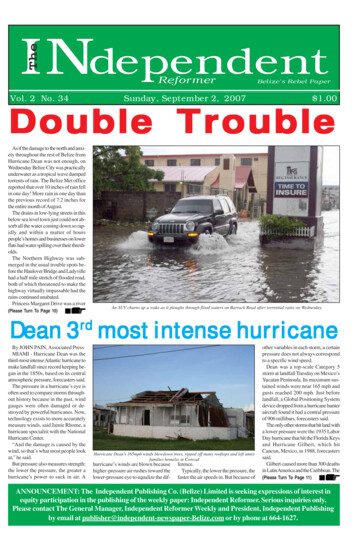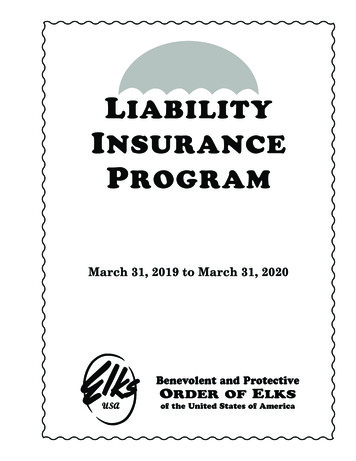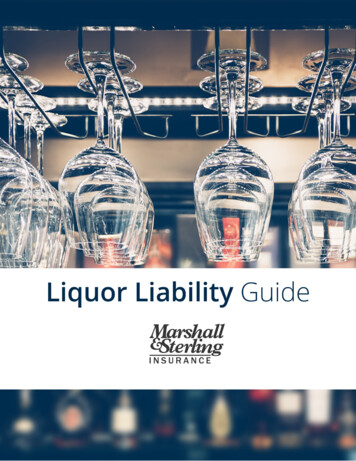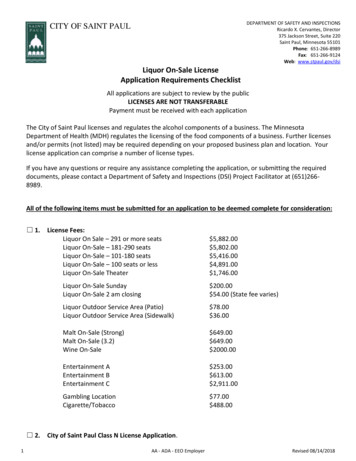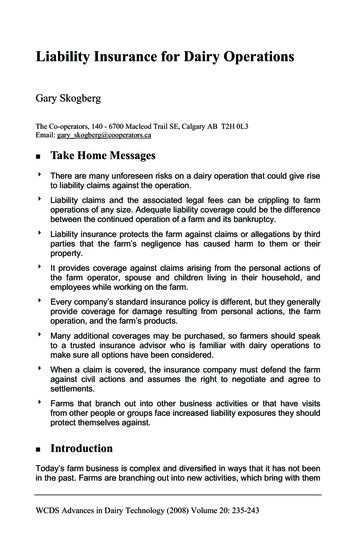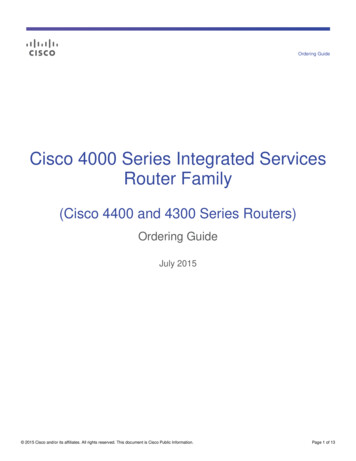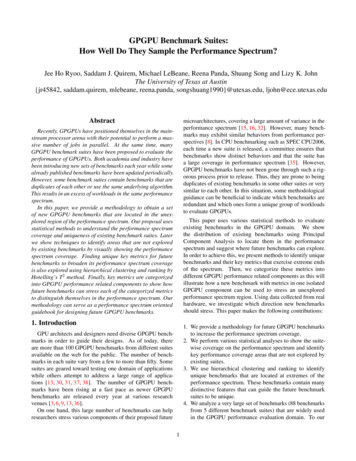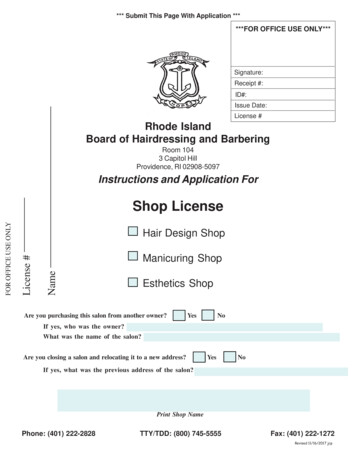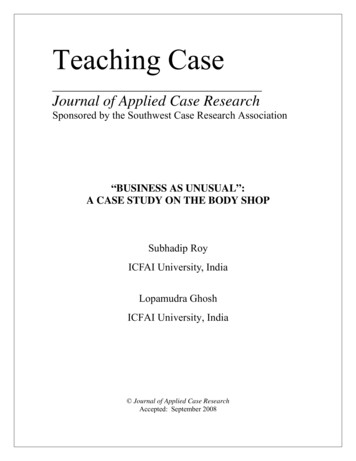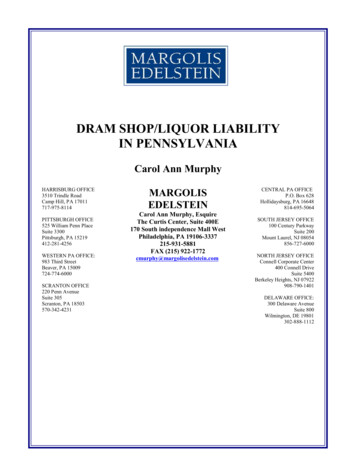
Transcription
DRAM SHOP/LIQUOR LIABILITYIN PENNSYLVANIACarol Ann MurphyHARRISBURG OFFICE3510 Trindle RoadCamp Hill, PA 17011717-975-8114MARGOLISEDELSTEINCENTRAL PA OFFICEP.O. Box 628Hollidaysburg, PA 16648814-695-5064PITTSBURGH OFFICE525 William Penn PlaceSuite 3300Pittsburgh, PA 15219412-281-4256Carol Ann Murphy, EsquireThe Curtis Center, Suite 400E170 South independence Mall WestPhiladelphia, PA 19106-3337215-931-5881FAX (215) 922-1772SOUTH JERSEY OFFICE100 Century ParkwaySuite 200Mount Laurel, NJ 08054856-727-6000WESTERN PA OFFICE:983 Third StreetBeaver, PA 15009724-774-6000SCRANTON OFFICE220 Penn AvenueSuite 305Scranton, PA H JERSEY OFFICEConnell Corporate Center400 Connell DriveSuite 5400Berkeley Heights, NJ 07922908-790-1401DELAWARE OFFICE:300 Delaware AvenueSuite 800Wilmington, DE 19801302-888-1112
DRAM SHOP/LIQUOR LIABILITY IN PENNSYLVANIAA.LIQUOR CODEThe Pennsylvania Liquor Code, Section 4-493(1) provides the basis for imposing liabilityfor negligent service of alcohol by liquor licensees.1.Section 4-493 of the Liquor Code provides, in pertinent part:It shall be unlawful –(1)Furnishing liquor or malt or brewed beverages to certain persons. For anylicensee or the board, or any employee, servant or agent of such licenseeor of the board, or any other person, to sell, furnish or give any liquor ormalt or brewed beverages, or to permit any liquor or malt or brewedbeverages to be sold, furnished or given, to any person visibly intoxicated,or to any minor: Provided further, that notwithstanding any otherprovision of law, no cause of action will exist against a licensee or theboard or any employee, servant or agent of such licensee or the board forselling, furnishing or giving any liquor or malt or brewed beverages orpermitting any liquor or malt or brewed beverages to be sold, furnished orgiven to any insane person, any habitual drunkard or person of knownintemperate habits unless the person sold, furnished or given alcohol isvisibly intoxicated or is a minor.2.Section 47 P.S. 4-497 provides as follows:No licensee shall be liable to third persons on account of damagesinflicted upon them off the licensed premises by customers of the licenseeunless the customer who inflicts the damages was sold, furnished or givenliquor or malted or brewed beverages by the said licensee or his agent,servant or employee when the said customer was visibly intoxicated.The Pennsylvania courts have clearly held that in order for a liquor licensee to be liableto a third person there must be service of alcohol to a visibly intoxicated person. Jardine v.Upper Darby Lodge No. 1973, Inc., 413 Pa. 626, 198 A.2d 550 (1964). Furthermore, the courtshave held that Section 4-497 "does not create a cause of action against the licensee but in factlimits the extent of a licensee’s liability." Detwiler v. Brumbaugh, 441 Pa. Super. 110, 656 A.2d944 (1955).The Court in Detwiler explained that:Traditionally, liability is established after a finding is made that a
duty existed, a breach of that duty occurred and the resulting harmwas proximately caused by the breach. Fennell v. National MutualFire Insurance Company, 412 Pa. Super. 534, 603 A.2d 1064(1992), allocatur denied, 533 Pa. 600, 617 A.2d 1274 (1992).Section 4-493 of the Liquor Code sets forth the duties associatedwith the service of alcohol.Id. at 946.Additionally, the Court in Detwiler stated that:This section clearly imposes a duty on those parties identified torefrain from selling liquor to a visibly intoxicated individual. ‘Aviolation of the requirements of this statute is deemed negligentper se, and if the violation is the proximate cause of plaintiff’sinjuries, then the defendant is liable.’Id. at 946.It is clear from the Detwiler case as well as other cases that the PennsylvaniaLiquor Code, Sections 4-493 and 4-497, provides the basis for a claim concerning the service ofalcohol. Id. The law is quite clear that visible intoxication is a necessary element to establishliability against a licensee. 47 P.S. §4-497. That is, Section 4-497 specifically states that therewill be no liability unless there is service of alcohol to one who is visibly intoxicated.Furthermore, as noted above, if plaintiff proves a violation has occurred, plaintiff must stillprove that the violation was the proximate cause of the plaintiff’s injuries.As stated in Fandozzi v. Kelly Hotel, 1998 Pa. Super. , 711 A.2d 524, 525-26(1998) appeal denied, 558 Pa. 601, 735 A.2d 1269 (1999), plaintiff must prove two things inorder to establish liability against a liquor licensee.That is, the plaintiff must prove thefollowing:1.That an employee or agent of the licensee served alcoholic beverages to acustomer while visibly intoxicated; and2.That this violation of the statute proximately caused the plaintiff’sinjuries.
Id. It is not sufficient for a plaintiff to establish merely that alcoholic beverages were served to apatron or that the patron was intoxicated at the time he or she caused injury to another. For civilliability to attach, evidence must be produced indicating that the patron was served alcohol at atime when he or she was visibly intoxicated. Id. at 527.B.PROOF OF VISIBLE INTOXICATIONTo establish a state of visible intoxication, proof of service and consumption of alcohol isnot sufficient; instead, to establish that a patron was served alcoholic beverages while visiblyintoxicated, the plaintiff must prove that the patron exhibited signs of visible intoxication beforebeing served their last drink and that someone saw the patron exhibit such signs. McDonald v.Marriott, 388 Pa. Super. 121, 564 A.2d 1296, 1299 (1989).However, it would appear, based on Pennsylvania case law that both direct andcircumstantial evidence will be considered in evaluating whether the plaintiff can establish thatan individual was served alcohol at a time when said individual was visibly intoxicated in theabsence of direct eyewitness evidence. Although from a defense perspective, one would like toargue that the McDonald case, as noted above, and the case of Johnson v. Harris, 419 Pa. Super.541, 615 A.2d 771 (1992) require that direct eyewitness evidence of the alleged intoxicatedperson is necessary for plaintiff to meet her burden of proof, the Pennsylvania Superior Court, inFandozzi v. Kelly Hotel, Inc., supra, 711 A.2d at 527, held differently:We note, however, that in the 18 years since Couts was decided,neither this court nor our Supreme Court has held that directevidence is required to prove that a patron was served alcoholwhile visibly intoxicated. Subsequent decisions of this court haveaddressed Couts, noting that it is not binding, but neverthelessexamining whether similar circumstantial evidence has beenpresented. . Accordingly, we conclude that a plaintiff can provedram shop liability in the absence of direct eye witness testimonythat an individual was served at a time when he or she was visiblyintoxicated. Id. at 527.One way a plaintiff may attempt to establish visible intoxication has been the use of the
results of a blood alcohol test performed after the happening of the accident and "the relationback" by an expert to establish that the individual would have been appeared intoxicated at thetime he was served the alcohol. However, the Pennsylvania Superior Court in Conner v. Duffy,438 Pa. Super. 277, 652 A.2d 372 (1994) held that such evidence, without more, is insufficientto permit the case to go to a jury. Id.In discussing this issue, the Court in Conner, noted that the evidence in that case couldnot rise to the level of establishing a general issue of material fact simply through the "relationback" testimony of the expert. Id. at 375. The Court noted that in Johnson v. Harris, 419 Pa.Super. 541, 615 A.2d 771 (1992), the Superior Court warned:The Pennsylvania Supreme Court has on various occasionsdiscussed the complexity of "relation back" and has indicated thatit should be used guardedly. We are accordingly wary of anyattempt to create genuine issue of fact as to "visible intoxication"based on medical testimony of what the average person’s reactionmight have been assuming [the driver’s] "probable" blood alcoholconcentration.Furthermore, the Pennsylvania Superior Court in Suskey v. Loyal Order of Moose LodgeNo. 86, 325 Pa. Super.94, 472 A.2d 663 (1994), held that a jury instruction on the presumptionof legal intoxication that is set forth in the motor vehicle Code 75 Pa. C.S.A. §1547(d) is notproper since a person who might be "legally" intoxicated under that presumption would notnecessarily be "visibly" intoxicated as required by the Dram Shop Act. Also, see Estate ofMickens v. Stevenson, 2002 Pa. Dist. and Cnty. Dec. Lexis 131; 57 Pa. D. & C. 4th 287 (2002) .In said case, the Court of Common Pleas of Fayette County granted the Motion for SummaryJudgment of the owner of the first bar as there was no evidence of negligence or violation of theDramshop Act. The court found no liability under the Dramshop Act, Pa. Stat. Ann. Tit. 47,Subsections 4-497 or 4-493 as the plaintiffs failed to present an issue of fact regarding whetherthe patron was visibly intoxicated within the meaning of the statute. In said case, the court setforth the proper meaning of “visibly intoxicated” as:
In defining the violation as the dispensation of alcoholicbeverages to a person ‘visibly intoxicated,’ the statute displaysconsiderable logic in placing stress upon what can be seen.The law does not hold a licensee or its agent responsible onany basis, such as blood alcohol level of a patron, which wouldnot be externally apparent; instead, the law decrees that thealcoholic beverage dispenser shall not provide more alcoholwhen the signs of intoxication are visible. The practical effectof the law is to insist that the licensee be governed by appearances,rather than by medical diagnoses.” Johnson vs. Harris, 419 Pa.Super., 541, 551, 615, A.2d 771, 776 (1992) (emphasis [*16] inoriginal) quoting Laukemann vs. Commonwealth of Pennsylvania.,82 Pa. Cmwlth. 502, 475, A.2d 955 (1984).Furthermore, the Court found that:.mere breach of the statutory duty to refrain from servingalcohol to visibly intoxicated persons does not alone establish liability,as plaintiff must also show that the breach was the proximate causeand cause in fact of an injury. Id. Thus, in order for an injured plaintiffto recover under the Dram Shop Act provision prohibiting service ofalcohol to visibly intoxicated persons, the following two things must beproven: (1) that the plaintiff was served alcoholic beverageswhile visibly intoxicated, and (2) that the violation proximately causedinjuries. See Johnson vs. Harris, 419 Pa. Super. 541, 550, 615 A.2d771, 775 (1992). See also, Fandozzi vs. Kelly Hotel, Inc., 711 A.2d 524(Pa. Super. 1998), allocatur denied, 558 Pa. 601, 735 A.2d 1269 (1999).However, if the plaintiff is able to establish other evidence, the Courts have allowedexpert testimony of the toxicologist. See Fandozzi v. Kelly Hotel, Inc., supra, 711 A.2d at 527.In that case, the Court concluded that the blood alcohol content and the opinions of thetoxicology expert were supported by additional circumstantial evidence indicating that thedecedent was visibly intoxicated while in the bar. Therefore, although the Court noted that thiscourt had been "wary of an attempt to create general issue of material fact as to ‘visibleintoxication’ based on medical testimony of what the average person’s reaction might have beenassuming ([the patron’s]) ‘probable’ blood alcohol concentration", the Court found that in thiscase there was other evidence. Fandozzi v. Kelly Hotel, Inc., supra, 711 A.2d at 528-529. Alsosee, Jardine v. Upper Darby Lodge No. 1993, Inc., supra, 198 A.2d at 550. In Jardine, thePennsylvania Supreme Court discussed the use of expert opinion in a dram shop case. The Court
found that the doctor’s testimony about the patron’s physical condition and his opinion that hewould have been intoxicated when served his last drink at the bar were admissible because thetestimony did not stand alone. However, the Pennsylvania Superior Court in the Estate of Cronv. Club North 40, No. 0168 M.D. appeal DKT. 1997, 552 Pa. 269, 714 A.2d 1024 found that theexpert opinion of the toxicologist "relating back" to the blood alcohol level was not sufficient tocreate a genuine issue of fact as to visible intoxication and found in favor of the liquorestablishment. The Honorable Judge Russell Nigro wrote a dissenting opinion in which hebelieved that there was sufficient evidence of visible intoxication by individuals on the sceneafter the accident and that such evidence as well as the expert opinion should have beenconsidered and should have prevented summary judgment from being granted.The plaintiff may attempt to introduce the criminal conviction of a DUI in a case inwhich the driver and the bar establishment have been sued. The defense should object to theadmission of a such a conviction.As noted above, although one may be found legallyintoxicated, this does not establish visible intoxication. Furthermore, evidence of the criminalconviction would be highly prejudicial to the bar establishment.C.LIABILITY FOR SERVICE OF ALCOHOL TO MINORSOriginally, the Superior Court in Simon vs. Shirley, 269 Pa. Super. 364, 409 A.2d 1365(1979) held that mere service by a liquor establishment of alcoholic beverages to a minor wasnot sufficient to render the licensee liable. The Superior Court in that case indicated visibleintoxication was needed. However, in a series of cases by the Pennsylvania Supreme Courtthereafter, the Pennsylvania Supreme Court overruled Simon vs. Shirley.In Matthews vs. Konieczny, 515 PA. 106, 527 A.2d 508 (1987) and Mancuso vs.Bradshaw, 338 Pa. Super. 328, 487 A.2d 990 (1985), the Pennsylvania Supreme Court, in theconsolidated appeals, held that: (1) The service of alcoholic beverages to minors in violation ofthe liquor code formed the basis for a finding of negligence with regard to those subsequently
affected by the legal service, even if beverages were served to one other than the ultimate actorin the ensuing automobile accident, i.e. the driver; and (2) the statutory "immunity" found at 47P.S. 4-497 applied only to "legally competent" customers and did not, therefore, insulate alicensee from liability resulting from sales to minors, thus, negating the necessity of showingthat the minor customer was visibly intoxicated at the time of purchase.In Matthews, Matthew Capriatti, age 17 purchased a case of beer from the defendantdistributor without being asked for verification or proof of age. In the Capriatti vehicle wasanother minor, James Matthews. Later, Capriatti and Matthews picked up John Konieczny.Eventually, Konieczny elected to be the driver of the automobile in which the three minors wereriding. By that time, Konieczny had consumed five (5) or six (6) 16 ounce beers. He lostcontrol of the car and struck a tree. James Matthews was killed. In Mancuso, William McGee(age 20) bought a case of beer from the defendant beer distributor. Thereafter, defendant,Richard Bradshaw, 19 years old, consumed approximately one-half of the case of beer.Thereafter, Bradshaw operated a motor vehicle which was involved in an accident with theplaintiff, Christina Mancuso.Furthermore, the Pennsylvania Superior Court in Thomas vs. Duquesne Light Company,396 Pa. Super. 1, 545 A.2d 289 (1988) held that a beer distributor’s duty to refrain from sellingalcohol to minors can be breached by an indirect sale to a minor through an adult intermediary ifit is known or should have been known by the licensee that the alcohol was being purchased forthe use of a minor. Also, see Reber vs. The Commonwealth PA Liquor and Control Board, 101Pa. Cmwlth. 397, 516 A.2d 440 (1986) in which the Commonwealth Court held that thePennsylvania Liquor Control Board also owes a duty not to furnish liquor to minors eitherdirectly or through likely intermediaries. A breach of this duty will yield liability if the breach isthe cause of the injuries suffered.Also, the Pennsylvania Supreme Court, in Congini vs. Porterville Value Company, 504
PA. 157 470 A.2d 515 (1983), found that social hosts may be liable for supplying minors withalcohol. In this case, the Pennsylvania Supreme Court determined that social hosts servingalcohol to minors to the point of intoxication are negligent per se and can be held liable forinjuries resulting from the minor’s intoxication. The Court found that the social host would beresponsible for injuries caused to the minor himself or to third parties. The court explained thereason for having a different rule for minors as opposed to adults served alcohol by a social hostas follows:However, our legislature has made a legislativejudgment that persons under twenty-one yearsof age are incompetent to handle alcohol. UnderSection 6308 of the Crimes Code 18 Pa. C.S.Section 6308, a person ‘less than twenty-one yearsof age’ commits a summary offense if he ‘attemptsto purchase, purchases, consumes, possesses ortransports any alcohol, liquor or malt or brewedbeverages’. Furthermore, under the Section 306of the Crimes Code, 18 Pa. C.S. Section 306, anadult who furnishes liquor to a minor would beliable as an accomplice to the same extent as theoffending minor.The legislative judgment compels a different resultfrom Klein, for here we are not dealing with theordinary able bodied men. Rather, we are confrontedwith persons who are, at least in the eyes of the law,incompetent to handle the affect of alcohol. Id.at 517.The Pennsylvania Supreme Court, in Orner vs. Malick, 432 Pa. 580, 515 Pa. 132, 527A.2d 521 (1987), further interpreted the decision in Congini to hold that the service ofintoxicating liquors to a minor by a social host is negligence per se, even if the liquors are notserved to the point of intoxication. The Pennsylvania Supreme Court found that the SuperiorCourt, in Orner, had narrowly interpreted Congini to indicate that the plaintiff had to proveservice to the point of intoxication before liability would be imposed on a social host. Instead,the Pennsylvania Supreme Court in Orner rejected such a narrow reading of Congini and made it
clear that any service of alcohol to a minor can yield liability and again emphasized the reasonsfor such a strict rule. Orner vs. Malick, supra, 527 A.2d at 521.In Orner, the plaintiff, 19 ½ years old, attended a series of high school graduation partiesduring a particular night in June of 1981. At the home of an acquaintance, plaintiff was servedintoxicating liquor. The same was true at a home of a second acquaintance. Finally, at theRegency Hotel, the minor plaintiff was served intoxicating beverages again. At the Hotel, theplaintiff, now intoxicated, fell over a second floor railing and sustained serious injuries. Thedefendants/social hosts filed preliminary objections which, were argued before the issuance ofthe Supreme Court decision in Congini vs. Porterville. Therefore, the lower court held that nosocial host liability existed even for service to a minor and dismissed the complaint. However,after the decision in Congini, the Superior Court affirmed the lower court’s order finding thateven under Congini, the plaintiff had failed to state a cause of action against one of the socialhosts whom he had visited before going to the Regency Hotel.However, as noted above, the Pennsylvania Supreme Court, found that the SuperiorCourt narrowly read its prior holding and, instead, found that the holding in Congini was to beread that any service of alcohol to a minor can yield liability. Thus, the social host of theplaintiff could be liable.The Pennsylvania Superior Court in Jefferis vs. The Commonwealth of Pennsylvania, 371Pa. Super. 12, 537 A.2d 355 (1988) established a tripartite test to determine whether a social hostwould be subject to liability for injuries arising out of a minor’s intoxication. The Court outlinedthe following test to be used:(1) the defendant must have intended to act insuch a way as to furnish, agree to furnish orpromote the furnishing of alcohol to a minor,(2) the defendant must of acted in a way whichdid furnish, agree to furnish, or promote the furnishingof alcohol to a minor; and
(3) the defendant’s act must have been a substantialfactor in furnishing, agreement to furnish, or thepromotion of alcohol to the minor.The Court also noted that factors relevant to determining whether the defendant’s act wasa substantial factor in the commission of the tort included the nature of the act incurred, theamount of assistance given, the defendant’s presence or absence at the time of the tort, thedefendant’s relation to the tortfeasor and foreseeability of the harm that occurred. Id. at 358citing Section 876 of the Restatement (Second) Torts.After Jefferies, the Pennsylvania Supreme Court again addressed the issue of social hostliability in Alumni Association vs. Sullivan, 524 Pa. 356 Pa. 572 A.2d 1209. In Alumni, thePennsylvania Supreme Court concluded that the social hosts liability extends only to personswho "knowingly furnish" alcohol to minors. Consequently, the court refused to impose liabilityon a university and the national fraternity for injuries suffered by a minor after an alcohol partyheld in a dormitory and hosted by a fraternity’s local chapter. The court refused to imposeliability because there was no indication that either the fraternity or the university was involvedin the planning or serving, supplying or purchasing the alcohol. The Pennsylvania Superiorfollowed this reasoning in Millard vs. Osbourne, 416 Pa. Super. 475 , 611 A.2d 715 and Kapresvs. Heller, 1992 Pa. Super. Lexis 2310, 612 A.2d 987 (1992).As to the liability of a minor social hosts to another minor, the Pennsylvania SupremeCourt in Kapres vs. Heller, 536 Pa. 550, 640 A.2d 888 (1994), held that a minor cannot be liablefor serving alcohol to another minor. The Pennsylvania Supreme Court affirmed that theSuperior’s Court decision in Kapres. For discussion of the difference in a civil case veruscriminal case, see Commonwealth of PA vs. Lawson, where the court noted that although liabilitydid not exist in a civil case, a minor could be criminally liable for furnishing alcohol to anotherminor.
As to defenses available to a party in cases involving minors, see discussion belowconcerning defenses.D. LIABILITY OF SOCIAL HOSTS (ADULTS):The Pennsylvania Courts have refused to extend liability under the liquor code to nonlicensed persons who furnish intoxicants to individuals in a state of visible intoxication. See,Manning vs. Andy, 454 Pa. 237, 310 A.2d 75 (1973). Also, see Klein vs. Raysinger, Pa. 141 470A.2d 507 (1983).As to liquor liability being found against an employer, the Pennsylvania Superior Courtin Burkhart vs. Brockway Glass Company, 325 Pa. Super. 204 507 A.2d 844 (1986) found thatan employer is not liable for the harm that results from its furnishing of alcoholic beverages toits visibly intoxicated employee and/or its failure to warn the employee against driving or failingto prevent the employee from operating a motor vehicle. The Court found that an employer hasno greater duty than any social host who furnished alcoholic beverages to an adult guest. Id.Also, see Sites vs. Cloonan, 328 Pa. Super. 481, 477 A.2d 547 (1984).In Sites, the Court held that a non commercial organization which sponsored a privatesocial gathering and acted strictly as a social host and gratuitously supplied liquor could not beheld liable to third parties injured when struck by an automobile driven by a guest who becameintoxicated at the event.E.LIABILITY OF VALET SERVICEIn Moranko vs. Downs Racing, L.P., 2015 W L 3609361, 2015 Pa. Super. 137, (2015) thePennsylvania Superior Court, in a case of first impression, held that there is no duty underPennsylvania law of a valet service when an automobile is returned to an allegedly intoxicatedperson. The entry of summary judgment for defendants was affirmed.
The estate claimed that the decedent consumed “copious amounts of alcohol” while atMohegan Sun Id. Thereafter, the decedent retrieved his vehicle from valet services, despite hisalleged visible intoxication. Id.The Superior Court accepted the plaintiff’s contention that the decedent was visiblyintoxicated while at Mohegan. The Superior Court found that the crux of the case hinged uponwhether Pennsylvania law imposes a duty upon Mohegan Sun and its valet service to withholdthe keys to a vehicle if the owner appears visibly intoxicated. The Superior Court found thatthere is no such duty. Id. In this case, plaintiff presented no evidence that Mohegan Sun servedalcohol to the decedent while he was at the casino prior to the accident in question.As to plaintiff’s argument that the valet service owed an affirmative duty to the decedent,plaintiff provided no specific case law and, instead, relied upon general concepts of “ordinarycare” and public policy to create such a duty. More specifically, plaintiff relied upon Section324A of the Restatement (Second) of Torts, Liability to Third Person for Negligent Performanceof Undertaking. Id. The Superior Court found that Section 324A provides no basis for relief. Id.Alternatively, plaintiff argued that Mohegan’s duty is based upon internal organizationalpolicies “designed to identify visibly intoxicated patrons and to prevent them [sic] from thegaming floor”. Id. However, the Pennsylvania Superior Court found that this policy did not placea legal duty on Mohegan Sun. Id.Plaintiff also relied on an employee training program regarding alleged prohibition ofserving of alcohol to visibly intoxicated gaming patrons. However, the Superior Court foundthat this internal policy did not require valets to withhold an automobile. Id.Although plaintiff, on appeal, for the first time, raised that the issue that Section 323 ofRestatement (Second) Torts is applicable, the Superior Court found that plaintiff waived said
argument. Id. Therefore, this argument was not addressed except by Judge Mundy in hisdissenting opinion. Id.Lastly, the Superior Court found that “Although no Pennsylvania appellate decisionaddresses the specific issue of parking attendant/valet liability, a number of other jurisdictionshave reached the same conclusion as in Mills vs. Continental Parking Corp., 86 Nev. 724, 475 P.2nd 673 (1970)].” Id. In Mills, the court held that a parking lot attendant could not be liable forsurrendering a vehicle to its intoxicated driver. Id. In Moranko, the Superior Court found thatthe reasoning in Mills applied. Id.F.PLEADINGSA significant number of complaints filed on behalf of plaintiffs include allegations ofcommon law negligence in addition to the allegations of the liquor liability under the liquorcode.Specifically, plaintiffs may assert theories of common law negligence in which theplaintiff claims that the defendant failed to have policies or protocols in place to train employeeswith regards to the use and consumption of alcohol; defendant failed to have limits on the timeduring which patrons may consume alcohol; defendant failed to have in place a program orwritten courses of action to be taken when a person is visibly intoxicated; defendant failed totrain, educate and supervise employees so as to prevent service or sale of alcohol to persons soas to cause intoxication; defendant failed to provide transportation for the alleged intoxicatedpatron; or defendant failed to prevent the alleged intoxicated patron from operating his/hervehicle.A defendant when faced with such allegations of common law negligence should filepreliminary objections to said allegations. (If the time period for Preliminary Objections hasexpired, then defendant can file a Motion for Judgment on the Pleadings or a Motion for
Summary Judgment regarding these allegations.)Defendant should assert that there are nocommon law liabilities of a bar establishment to third persons arising from the sale of alcohol.That is, the bar establishment should argue that the only cause of action permitted byPennsylvania law is contained in Section 4-497 of the Dram Shop Act, which limits liability to ashowing that a patron was served alcoholic beverages by a licensee while visibly intoxicated andthat such service was the proximate cause of the plaintiff’s injury.Recently, Pennsylvania trial courts have granted preliminary objections on the basis thatthere does not exist a common law negligence claim under Pennsylvania law.The United States District Court for the Eastern District of Pennsylvania, addressed saidissue in Druffner v. O’Neill, No. 10-04298, 2011 WL 1103647 (E.D. Pa. March 24, 2011). InDruffner, the estate of Patricia Murphy Waggoner filed a Compliant alleging a claim forviolation of the Pennsylvania Dram Shop Act, 47 P.S. Sections 4-493(1) and 4-497 and a claimfor common law negligence against a licensed server of alcohol. In said case, the common lawnegligence claim specifically alleged that the licensee was negligent in failing to ensure that theintoxicated person did not operate a vehicle, for failing to make any effort to notify theintoxicated person’s friend of her condition and/or failing to contact police to advise of thedanger posed by the intoxicated person. Druffner v. O’Neill, No. 10-04298, 2011 WL 1103647(E.D. Pa. March 24, 2011).The Druffner court held that “it is clear that plaintiff has failed to state a cognizable claimunder common law principles of negligence.” Druffner v. O’Neill, No. 2011 WL 1103647 at *4.In dismissing the common law negligence claim, the court reasoned that “there was no duty tocontrol the conduct of a third party to prevent another from harm, except where defendant standsin some special relationship with the intended victim of the conduct which gives the intended
victim a right to protection.” Druffner, supra, 2011 WL 1103647 at *4. Furthermore, theCourt’s survey of the law (including that of other jurisdict
DRAM SHOP/LIQUOR LIABILITY IN PENNSYLVANIA A. LIQUOR CODE The Pennsylvania Liquor Code, Section 4-493(1) provides the basis for imposing liability . Fire Insurance Company, 412 Pa. Super. 534, 603 A.2d 1064 (1992), allocatur denied, 533 Pa. 600, 617 A.2d 1274 (1992). Section 4-493 of the Liquor Code sets forth the duties associated .
